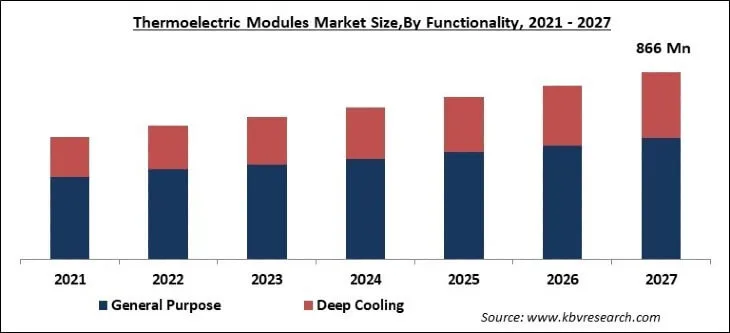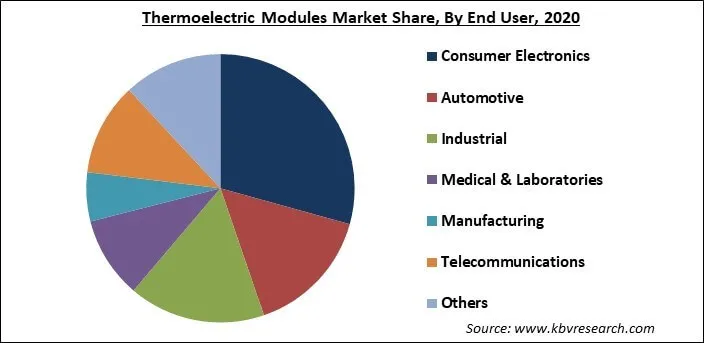The Global Thermoelectric Modules Market size is expected to reach $866 Million by 2027, rising at a market growth of 7.3% CAGR during the forecast period. Some of the other names of thermoelectric modules are Peltier cooler or thermoelectric cooler. It is a semiconductor-based electronic element. The thermoelectric module acts as a small heat pump that circulates heat from one side to another side of the device. In thermoelectric modules, heat pumps are attached in them that can obtain water from the air through the structured circuit engineering in the device works on the principle of the Peltier Effect. Thermoelectric modules are mostly used to produce electricity with the help of temperature variance between the two sides of the module.
The main applications of thermoelectric modules include heat pumping, power generation, and temperature stabilization. While in notable applications, thermoelectric modules are installed to give variant temperatures, includes a switch in opposition to modify from warming to cooling. This process is used to attain a rapid cyclic temperature called thermal cycling. In addition to it, these cyclic thermoelectric modules are also used to reduce the surface area primarily affected by the expansion and contraction of the ceramic substrates.

Semiconductor industries are growing very rapidly across the world. It is due to the rising adoption of semiconductors in several other sectors including automobiles and electronics. The demand for thermoelectric modules is also likely to grow during the forecast period. For example, the present rank of IBD's Electronics-Semiconductor Manufacturing group is 36 in total 197 industry groups, according to Investor's Business Daily. The group comprises 32 semiconductor companies. Thermoelectric generators are solid-state semiconductor devices that convert heat flow and several; temperature differences into useful DC sources of power.
The outbreak of the COVID-19 pandemic, which is considered as a fatal respiratory disease has also affected the thermoelectric modules market. The COVID-19 pandemic would ensure variant degree of impact on different types of thermoelectric modules. So, the COVID-19 pandemic has adversely impacted the thermoelectric coolers market. It is mainly due to the dip in aerospace, industrial, and automotive applications. Consumer electronics have witnessed a decline in revenue initially but are likely to recover from 2021 onward. Telecommunications and medical segments also experienced a slight decline due to complete lockdown since remote communications, medicine/vaccine storage and transport and pharmaceutical research have assumed the place of crucial activities during the pandemic.
Based on Offering, the market is segmented into Hardware and Services. The Hardware market dominated the Global Thermoelectric Modules Market by Offering 2020, growing at a CAGR of 6.4 % during the forecast period. The Services market is expected to witness a CAGR of 9.3% during (2021 - 2027).
Based on Type, the market is segmented into Bulk, Micro and Thin-Film. Micro thermoelectric modules are showing the highest growth owing to applications in telecommunications and automotive. The high adoption of 5G communication is the main driving factor that necessitates micro thermoelectric modules. The micro thermoelectric modules are used in automotive for cooling several sensors and improve driving aid. Therefore, the market for micro thermoelectric modules would witness fastest growth rate during the forecast period.
Based on Model, the market is segmented into Single Stage and Multi Stage. There are many benefits of the single-stage module such as it covers a broad range of commercial, consumer, and industrial needs. As it is available in different shapes and sizes which make them capable of pumping heat at different levels. Designs of single-stage thermoelectric modules are less complicated in comparison to multistage modules.

Based on Functionality, the market is segmented into General Purpose and Deep Cooling. Thermoelectric modules provide in-depth cooling due to the superior material efficiency which allows components to operate at low temperatures that leads to higher effectiveness. Wine cabinets, mini-refrigerators, and air conditioners are often employed across different industries in the North American region.
Based on End User, the market is segmented into Consumer Electronics, Automotive, Industrial, Medical & Laboratories, Manufacturing, Telecommunications and Others. Thermoelectric modules used in consumer electronics garnered the maximum share of the thermoelectric modules market and the segment would exhibit the similar trend even during the forecast period. Makers in Consumer electronics market must consistently innovate and enhance designs to create smaller, thinner, lighter, and more reliable products that cater to the increasing customer demands.
| Report Attribute | Details |
|---|---|
| Market size value in 2020 | USD 495.1 Million |
| Market size forecast in 2027 | USD 866 Million |
| Base Year | 2020 |
| Historical Period | 2017 to 2019 |
| Forecast Period | 2021 to 2027 |
| Revenue Growth Rate | CAGR of 7.3% from 2021 to 2027 |
| Number of Pages | 278 |
| Number of Tables | 540 |
| Report coverage | Market Trends, Revenue Estimation and Forecast, Segmentation Analysis, Regional and Country Breakdown, Companies Strategic Developments, Company Profiling |
| Segments covered | Offering, Type, Model, Functionality, End User, Region |
| Country scope | US, Canada, Mexico, Germany, UK, France, Russia, Spain, Italy, China, Japan, India, South Korea, Singapore, Malaysia, Brazil, Argentina, UAE, Saudi Arabia, South Africa, Nigeria |
| Growth Drivers |
|
| Restraints |
|
Based on Regions, the market is segmented into North America, Europe, Asia Pacific, and Latin America, Middle East & Africa. With a growing number of industries across the North American region, the demand for a device that can regulate cooling and temperature where conventional cooling systems are not viable is constantly increasing. Many global companies and tech giants have their HQs in this region. Consumer applications are highly deploying thermoelectric modules to offer cooling and temperature control. There are infinite benefits of installing thermoelectric modules such as they have small size and lightweight, capability to cool below room temperature, and no moving components.
Free Valuable Insights: Global Thermoelectric Modules Market size to reach USD 866 Million by 2027
The market research report covers the analysis of key stake holders of the market. Key companies profiled in the report include Ferrotec Holdings Corporation, II-VI, Incorporated, Vishay Precision Group, Inc., Phononic, Inc., Z-Max Co., Ltd., Thermion, Inc., Kryotherm, TEC Microsystems GmbH, TE Technology, Inc., and Laird Thermal Systems, Inc.
By Offering
By Type
By Model
By Functionality
By End User
By Geography


The global thermoelectric modules market size is expected to reach $866 Million by 2027.
Growing applications of thermoelectric modules in different industries are driving the market in coming years, however, advantage of TEMs over conventional systems have limited the growth of the market.
Ferrotec Holdings Corporation, II-VI, Incorporated, Vishay Precision Group, Inc., Phononic, Inc., Z-Max Co., Ltd., Thermion, Inc., Kryotherm, TEC Microsystems GmbH, TE Technology, Inc., and Laird Thermal Systems, Inc.
The expected CAGR of the thermoelectric modules market is 7.3% from 2021 to 2027.
Telecommunications and medical segments also experienced a slight decline due to complete lockdown since remote communications, medicine/vaccine storage and transport and pharmaceutical research have assumed the place of crucial activities during the pandemic.
Bulk thermoelectric modules obtained the maximum share of the thermoelectric modules market in 2020.
Our team of dedicated experts can provide you with attractive expansion opportunities for your business.

